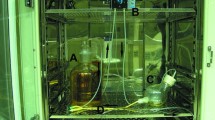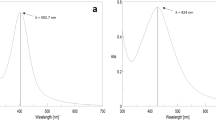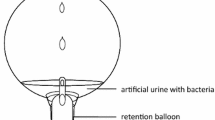Abstract
This study aimed to assess the activity of AgNPs biosynthesized by Fusarium oxysporum (bio-AgNPs) against multidrug-resistant uropathogenic Proteus mirabilis, and to assess the antibacterial activity of catheters coated with bio-AgNPs. Broth microdilution and time-kill kinetics assays were used to determine the antibacterial activity of bio-AgNPs. Catheters were coated with two (2C) and three (3C) bio-AgNPs layers using polydopamine as crosslinker. Catheters were challenged with urine inoculated with P. mirabilis to assess the anti-incrustation activity. MIC was found to be 62.5 µmol l-1, causing total loss of viability after 4 h and bio-AgNPs inhibited biofilm formation by 76.4%. Catheters 2C and 3C avoided incrustation for 13 and 20 days, respectively, and reduced biofilm formation by more than 98%, while the pristine catheter was encrusted on the first day. These results provide evidence for the use of bio-AgNPs as a potential alternative to combat of multidrug-resistant P. mirabilis infections.





Similar content being viewed by others
Data Availability
Not applicable.
Code Availability
Not applicable.
References
Flores-Mireles AL, Walker JN, Caparon M, Hultgren SJ (2015) Urinary tract infections: epidemiology, mechanisms of infection and treatment options. Nat Rev Microbiol 13:269–284. https://doi.org/10.1038/nrmicro3432
Holling N, Lednor D, Tsang S et al (2014) Elucidating the genetic basis of crystalline biofilm formation in Proteus mirabilis. Infect Immun 82:1616–1626. https://doi.org/10.1128/IAI.01652-13
Schaffer JN, Pearson MM (2015) Proteus mirabilis and urinary tract infections. Microbiol Spectr. https://doi.org/10.1128/microbiolspec.UTI-0017-2013
Norsworthy AN, Pearson MM (2017) From catheter to kidney stone: the uropathogenic lifestyle of Proteus mirabilis. Trends Microbiol 25:304–315. https://doi.org/10.1016/j.tim.2016.11.015
Rai MK, Deshmukh SD, Ingle AP, Gade AK (2012) Silver nanoparticles: the powerful nanoweapon against multidrug-resistant bacteria: activity of silver nanoparticles against MDR bacteria. J Appl Microbiol 112:841–852. https://doi.org/10.1111/j.1365-2672.2012.05253.x
Neethu S, Midhun SJ, Radhakrishnan EK, Jyothis M (2018) Green synthesized silver nanoparticles by marine endophytic fungus Penicillium polonicum and its antibacterial efficacy against biofilm forming, multidrug-resistant Acinetobacter baumanii. Microb Pathog 116:263–272. https://doi.org/10.1016/j.micpath.2018.01.033
Dakal TC, Kumar A, Majumdar RS, Yadav V (2016) Mechanistic basis of antimicrobial actions of silver nanoparticles. Front Microbiol. https://doi.org/10.3389/fmicb.2016.01831
Scandorieiro S, de Camargo LC, Lancheros CAC et al (2016) Synergistic and additive effect of oregano essential oil and biological silver nanoparticles against multidrug-resistant bacterial strains. Front Microbiol. https://doi.org/10.3389/fmicb.2016.00760
Park TJ, Lee KG, Lee SY (2016) Advances in microbial biosynthesis of metal nanoparticles. Appl Microbiol Biotechnol 100:521–534. https://doi.org/10.1007/s00253-015-6904-7
Durán N, Nakazato G, Seabra AB (2016) Antimicrobial activity of biogenic silver nanoparticles, and silver chloride nanoparticles: an overview and comments. Appl Microbiol Biotechnol 100:6555–6570. https://doi.org/10.1007/s00253-016-7657-7
Ding YH, Floren M, Tan W (2016) Mussel-inspired polydopamine for bio-surface functionalization. Biosurf Biotribol 2:121–136. https://doi.org/10.1016/j.bsbt.2016.11.001
Swartjes JJTM, Sharma PK, Kooten TG et al (2015) Current developments in antimicrobial surface coatings for biomedical applications. CMC 22:2116–2129. https://doi.org/10.2174/0929867321666140916121355
Su L, Yu Y, Zhao Y et al (2016) Strong antibacterial polydopamine coatings prepared by a shaking-assisted method. Sci Rep 6:24420. https://doi.org/10.1038/srep24420
Liu Y, Ai K, Lu L (2014) Polydopamine and its derivative materials: synthesis and promising applications in energy, environmental, and biomedical fields. Chem Rev 114:5057–5115. https://doi.org/10.1021/cr400407a
Zhou J, Xiong Q, Ma J et al (2016) Polydopamine-enabled approach toward tailored plasmonic nanogapped nanoparticles: from nanogap engineering to multifunctionality. ACS Nano 10:11066–11075. https://doi.org/10.1021/acsnano.6b05951
Fourie G, Steenkamp ET, Ploetz RC et al (2011) Current status of the taxonomic position of Fusarium oxysporum formae specialis cubense within the Fusarium oxysporum complex. Infect Genet Evol 11:533–542. https://doi.org/10.1016/j.meegid.2011.01.012
Khan MA, Khan SA, Waheed U et al (2021) Morphological and genetic characterization of Fusarium oxysporum and its management using weed extracts in cotton. J King Saud Univ - Sci 33:101299. https://doi.org/10.1016/j.jksus.2020.101299
Raeder U, Broda P (1985) Rapid preparation of DNA from filamentous fungi. Lett Appl Microbiol 1:17–20. https://doi.org/10.1111/j.1472-765X.1985.tb01479.x
White TJ, Bruns T, Lee S et al (1990) Amplification and direct sequencing of fungal ribosomal RNA genes for phylogenetics. PCR Protoc: Guide Methods Appl 18:315–322
O’Donnell K, Cigelnik E, Nirenberg HI (1998) Molecular systematics and phylogeography of the Gibberella fujikuroi species complex. Mycologia 90:465–493. https://doi.org/10.1080/00275514.1998.12026933
O’Donnell K, Gueidan C, Sink S et al (2009) A two-locus DNA sequence database for typing plant and human pathogens within the Fusarium oxysporum species complex. Fungal Genet Biol 46:936–948. https://doi.org/10.1016/j.fgb.2009.08.006
Lombard L, Sandoval-Denis M, Lamprecht SC, Crous PW (2019) Epitypification of Fusarium oxysporum – clearing the taxonomic chaos. Persoonia 43:1–47. https://doi.org/10.3767/persoonia.2019.43.01
Noriler SA, Savi DC, Aluizio R et al (2018) Bioprospecting and structure of fungal endophyte communities found in the brazilian biomes, pantanal, and cerrado. Front Microbiol 9:1526. https://doi.org/10.3389/fmicb.2018.01526
Noriler SA, Savi DC, Ponomareva LV et al (2019) Vochysiamides A and B: two new bioactive carboxamides produced by the new species diaporthe vochysiae. Fitoterapia 138:104273. https://doi.org/10.1016/j.fitote.2019.104273
Maryani N, Lombard L, Poerba YS et al (2019) Phylogeny and genetic diversity of the banana Fusarium wilt pathogen Fusarium oxysporum f. sp. cubense in the Indonesian centre of origin. Stud Mycol 92:155–194. https://doi.org/10.1016/j.simyco.2018.06.003
Wang MM, Crous PW, Sandoval-Denis M et al (2022) Fusarium and allied genera from China: species diversity and distribution. Persoonia 48:1–53. https://doi.org/10.3767/persoonia.2022.48.01
Ronquist F, Teslenko M, Van Der Mark P et al (2012) MrBayes 3.2: efficient bayesian phylogenetic inference and model choice across a large model space. Syst Biol 61:539–542. https://doi.org/10.1093/sysbio/sys029
Ariyawansa HA, Hawksworth DL, Hyde KD et al (2014) Epitypification and neotypification: guidelines with appropriate and inappropriate examples. Fungal Divers 69:57–91. https://doi.org/10.1007/s13225-014-0315-4
Durán N, Marcato PD, Alves OL et al (2005) Mechanistic aspects of biosynthesis of silver nanoparticles by several Fusarium oxysporum strains. J Nanobiotechnol 3:8. https://doi.org/10.1186/1477-3155-3-8
Clinical and Laboratory Standards Institute (2015) Methods for dilution antimicrobial susceptibility tests for bacteria that grow aerobically: M07-A10 ; approved standard, 10. ed. Committee for Clinical Laboratory Standards, Wayne, PA
Barry AL, Craig WA, Nadler H et al (1999) Methods for determining bactericidal activity of antimicrobial agents. Approv Guidel 19:1–3
Bazargani MM, Rohloff J (2016) Antibiofilm activity of essential oils and plant extracts against Staphylococcus aureus and Escherichia coli biofilms. Food Control 61:156–164. https://doi.org/10.1016/j.foodcont.2015.09.036
Chaieb K, Kouidhi B, Jrah H et al (2011) Antibacterial activity of thymoquinone, an active principle of Nigella sativa and its potency to prevent bacterial biofilm formation. BMC Complement Altern Med 11:29. https://doi.org/10.1186/1472-6882-11-29
Wang R, Neoh KG, Kang E et al (2015) Antifouling coating with controllable and sustained silver release for long-term inhibition of infection and encrustation in urinary catheters. J Biomed Mater Res 103:519–528. https://doi.org/10.1002/jbm.b.33230
Gholami-Shabani M, Akbarzadeh A, Norouzian D et al (2014) Antimicrobial activity and physical characterization of silver nanoparticles green synthesized using nitrate reductase from Fusarium oxysporum. Appl Biochem Biotechnol 172:4084–4098. https://doi.org/10.1007/s12010-014-0809-2
Raza M, Kanwal Z, Rauf A et al (2016) Size- and shape-dependent antibacterial studies of silver nanoparticles synthesized by wet chemical routes. Nanomaterials 6:74. https://doi.org/10.3390/nano6040074
Składanowski M, Golinska P, Rudnicka K et al (2016) Evaluation of cytotoxicity, immune compatibility and antibacterial activity of biogenic silver nanoparticles. Med Microbiol Immunol 205:603–613. https://doi.org/10.1007/s00430-016-0477-7
Srinivasan R, Vigneshwari L, Rajavel T et al (2018) Biogenic synthesis of silver nanoparticles using Piper betle aqueous extract and evaluation of its anti-quorum sensing and antibiofilm potential against uropathogens with cytotoxic effects: an in vitro and in vivo approach. Environ Sci Pollut Res 25:10538–10554. https://doi.org/10.1007/s11356-017-1049-0
Swarnavalli GCJ, Dinakaran S, Raman N et al (2017) Bio inspired synthesis of monodispersed silver nano particles using Sapindus emarginatus pericarp extract – Study of antibacterial efficacy. J Saudi Chem Soc 21:172–179. https://doi.org/10.1016/j.jscs.2015.03.004
Dhas SP, John SP, Mukherjee A, Chandrasekaran N (2014) Autocatalytic growth of biofunctionalized antibacterial silver nanoparticles: nanobiosynthesis of antibacterial AgNPs. Biotechnol Appl Biochem. https://doi.org/10.1002/bab.1161
Ruparelia JP, Chatterjee AK, Duttagupta SP, Mukherji S (2008) Strain specificity in antimicrobial activity of silver and copper nanoparticles. Acta Biomater 4:707–716. https://doi.org/10.1016/j.actbio.2007.11.006
Landini P (2009) Cross-talk mechanisms in biofilm formation and responses to environmental and physiological stress in Escherichia coli. Res Microbiol 160:259–266. https://doi.org/10.1016/j.resmic.2009.03.001
Hoffman LR, D’Argenio DA, MacCoss MJ et al (2005) Aminoglycoside antibiotics induce bacterial biofilm formation. Nature 436:1171–1175. https://doi.org/10.1038/nature03912
Aka ST, Haji SH (2015) Sub-MIC of antibiotics induced biofilm formation of Pseudomonas aeruginosa in the presence of chlorhexidine. Braz J Microbiol 46:149–154. https://doi.org/10.1590/S1517-838246120140218
Gambino M, Cappitelli F (2016) Mini-review: biofilm responses to oxidative stress. Biofouling 32:167–178. https://doi.org/10.1080/08927014.2015.1134515
Wang L, Hu C, Shao L (2017) The antimicrobial activity of nanoparticles: present situation and prospects for the future. IJN 12:1227–1249. https://doi.org/10.2147/IJN.S121956
Cho EJ, Holback H, Liu KC et al (2013) Nanoparticle characterization: state of the art, challenges, and emerging technologies. Mol Pharm 10:2093–2110. https://doi.org/10.1021/mp300697h
Bhatia S (2016) Natural Polymer Drug Delivery Systems. Springer International Publishing, Cham
Perikamana SKM, Shin YM, Lee JK et al (2017) Graded functionalization of biomaterial surfaces using mussel-inspired adhesive coating of polydopamine. Colloids Surf, B 159:546–556. https://doi.org/10.1016/j.colsurfb.2017.08.022
Milo S, Thet NT, Liu D et al (2016) An in-situ infection detection sensor coating for urinary catheters. Biosens Bioelectron 81:166–172. https://doi.org/10.1016/j.bios.2016.02.059
Rani SA, Celeri C, Najafi R et al (2016) Irrigation with N, N-dichloro-2,2-dimethyltaurine (NVC-422) in a citrate buffer maintains urinary catheter patency in vitro and prevents encrustation by Proteus mirabilis. Urolithiasis 44:247–256. https://doi.org/10.1007/s00240-015-0811-3
Morgan SD, Rigby D, Stickler DJ (2009) A study of the structure of the crystalline bacterial biofilms that can encrust and block silver Foley catheters. Urol Res 37:89–93. https://doi.org/10.1007/s00240-009-0176-6
Pickard R, Lam T, MacLennan G et al (2012) Antimicrobial catheters for reduction of symptomatic urinary tract infection in adults requiring short-term catheterisation in hospital: a multicentre randomised controlled trial. The Lancet 380:1927–1935. https://doi.org/10.1016/S0140-6736(12)61380-4
Funding
This study was financed by the Coordination for the Improvement of Higher Education Personnel—Brazil (CAPES) Finance Code 001.
Author information
Authors and Affiliations
Contributions
All authors contributed to the study conception and design. GIAS, GHMG, SAN, GFR and AGOd: Material preparation, data collection and analysis were performed. AGdO, GN and SPDR: The first draft of the manuscript was written, and all authors commented on previous versions of the manuscript. All authors read and approved the final manuscript.
Corresponding author
Ethics declarations
Conflict of interest
The authors declare that they have no known competing financial interests or personal relationships that could have appeared to influence the work reported in this paper.
Ethical Approval
This study was performed in line with the principles of the Declaration of Helsinki. Approval was granted by the Ethics Committee of University State of Londrina (CEP-UEL 1.590.120).
Consent to Participate
Informed consent was obtained from all individual participants included in the study.
Consent to Publication
All authors listed in this manuscript provide their consent for publication of the research article.
Additional information
Publisher's Note
Springer Nature remains neutral with regard to jurisdictional claims in published maps and institutional affiliations.
Supplementary Information
Below is the link to the electronic supplementary material.
Rights and permissions
Springer Nature or its licensor (e.g. a society or other partner) holds exclusive rights to this article under a publishing agreement with the author(s) or other rightsholder(s); author self-archiving of the accepted manuscript version of this article is solely governed by the terms of such publishing agreement and applicable law.
About this article
Cite this article
Saikawa, G.I.A., Guidone, G.H.M., Noriler, S.A. et al. Green-Synthesized Silver Nanoparticles in the Prevention of Multidrug-Resistant Proteus mirabilis Infection and Incrustation of Urinary Catheters BioAgNPs Against P. mirabilis Infection. Curr Microbiol 81, 100 (2024). https://doi.org/10.1007/s00284-024-03616-w
Received:
Accepted:
Published:
DOI: https://doi.org/10.1007/s00284-024-03616-w




